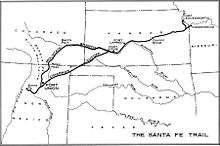Fort Union National Monument
| Fort Union National Monument | |
|---|---|
|
IUCN category V (protected landscape/seascape) | |
|
Fort Union Ruins | |
 | |
| Location | Mora County, New Mexico, USA |
| Nearest city | Las Vegas, New Mexico |
| Coordinates | 35°54′26″N 105°00′44″W / 35.9072620°N 105.0122258°W[1]Coordinates: 35°54′26″N 105°00′44″W / 35.9072620°N 105.0122258°W[1] |
| Area | 720.6 acres (291.6 ha)[2] |
| Established | June 28, 1954 |
| Visitors | 9,575 (in 2011)[3] |
| Governing body | National Park Service |
| Website | Fort Union National Monument |
|
Fort Union National Monument | |
| Built | 1851 |
| NRHP Reference # | 66000044[4] |
| Added to NRHP | October 15, 1966 |
Fort Union National Monument is a unit of the National Park Service located north of Watrous, Mora County, New Mexico, USA. The national monument was founded on June 28, 1954.
The site preserves the second of three forts constructed on the site beginning in 1851, as well as the ruins of the third. Also visible is a network of ruts from the Mountain and Cimarron Branches of the old Santa Fe Trail.[5]
There is a visitor center with exhibits about the fort and a film about the Santa Fe Trail. The altitude of the Visitor Center is 6760 feet (2060 m). A 1.2-mile (1.9-kilometre) trail winds through the fort's adobe ruins.
Description by William Davis
Santa Fe trader and author William Davis gave his first impression of the fort in the year 1857:
Fort Union, a hundred and ten miles from Santa Fé, is situated in the pleasant valley of the Moro. It is an open post, without either stockades or breastworks of any kind, and, barring the officers and soldiers who are seen about, it has much more the appearance of a quiet frontier village than that of a military station. It is laid out with broad and straight streets crossing each other at right angles. The huts are built of pine logs, obtained from the neighboring mountains, and the quarters of both officers and men wore a neat and comfortable appearance.[6]
F. Stanley wrote and published a book titled Fort Union New Mexico in 1953 giving a colorful history of this fort and individuals such as Davey Crockett.
Land ownership
In its forty years (1851–1891) as a frontier post, Fort Union had to defend itself in the courtroom as well as on the battlefield. When the United States Army built Fort Union in the Mora Valley in 1851, the soldiers were unaware that they had encroached on private property, which was part of the Mora Grant. The following year Colonel Edwin Vose Sumner expanded the fort to an area of eight square miles by claiming the site as a military reservation. In 1868 President Andrew Johnson declared a timber reservation, encompassing the entire range of the Turkey Mountains and comprising an area of fifty-three square miles, as part of the fort.[7]
The claimants of the Mora Grant immediately challenged the government squatters and took the case to court. By the mid-1850s, the case reached Congress. In the next two decades, the government did not give any favorable decision to the claimants, until 1876 when the Surveyor-General of New Mexico reported that Fort Union was "no doubt" located in the Mora Grant. But the army was unwilling to move to another place or to compensate the claimants because of the cost. The Secretary of War took "a prudential measure," protesting the decision of the acting commissioner of the General Land Office. He argued that the military had improved the area and should not give it up without compensation.[7] This stalling tactic worked; the army stayed at the fort until its demise in 1891, not paying a single penny to legitimate owners.
Gallery
 Map of the historic Santa Fe Trail
Map of the historic Santa Fe Trail- Part of the remainder of the fort
- Remainder of the fort
- View of the fort from a distance away
External links
| Wikimedia Commons has media related to Fort Union National Monument. |
- Fort Union National Monument official site
- Santa Fe Trail Research Site
- American Southwest, a National Park Service Discover Our Shared Heritage Travel Itinerary
References
- 1 2 "Fort Union National Monument". Geographic Names Information System. United States Geological Survey. Retrieved 2012-12-30.
- ↑ "Annual Report of Lands as of September 30, 2011" (PDF). United States Fish and Wildlife Service. Retrieved 2012-12-30.
- ↑ "NPS Annual Recreation Visits Report". National Park Service. Retrieved 2012-12-30.
- ↑ National Park Service (2009-03-13). "National Register Information System". National Register of Historic Places. National Park Service.
- ↑ Cultural Encounters at Fort Union
- ↑ William H. Davis, El Gringo − or New Mexico and Her People, Harper & Brothers Publishers, New York 1857 (online at: El Gringo), p. 51
- 1 2 U.S. Congress, Senate, Committee on Military Affairs, Title to certain Military and Timber Reservations. S. Rept. 621, 45th Cong., 3d sess., 1879, p. 3-4